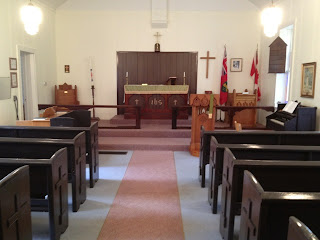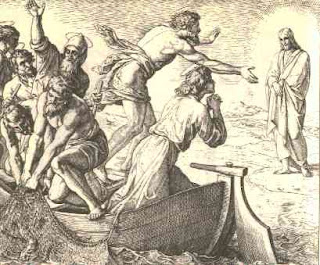A Dominion Reed Organ Diversion
 |
| St. Thomas' Anglican Church, Ullswater/Bent River Ontario |
This church is a delightful, small country church with a Sunday summer attendance of about 20-25, and it feels very full when there are that many people there! It meets year round and is supported by a faithful group of parishioners who love and care for it.
 |
| The Church sign. My friend the Rev. Peter Simmons is the Rector |
 |
| The bright, simple interior of the church. |
 I am told that the Church is actually a log structure that was shingled over sometime during the twentieth century. The interior has been panelled as well. Although I am not a fan of covering up the historical character of a place of worship, it has a lively, bright feel to it, which makes it a very pleasant place to worship. The ceiling is "domed" which allows for quite robust acoutics in such small building. But wait... look! What do we see up front on the epistle side of the church? Is that a reed organ?!
I am told that the Church is actually a log structure that was shingled over sometime during the twentieth century. The interior has been panelled as well. Although I am not a fan of covering up the historical character of a place of worship, it has a lively, bright feel to it, which makes it a very pleasant place to worship. The ceiling is "domed" which allows for quite robust acoutics in such small building. But wait... look! What do we see up front on the epistle side of the church? Is that a reed organ?! Why yes, it is! In addition to the modern electric organ (located on the Gospel side of the church) is an old Dominion Reed Organ. I noticed this treasure when I first preached at St. Thomas' some years ago, and although I was intrigued, I had little knowledge of reed organs in those days. Last summer, I decided to take a closer look...
The Dominion Organ Company of Bowmanville, Ontario, was an important Canadian manufacturer of Reed Organs. Rodney Jantzi has recently restored a Dominion organ and information about the Dominion Company can be found here. To view Rodney's Dominion Orchestral reed organ restoration project, click here.
 |
| A view of the Dominion logo on the bass side of the stop board. |
 |
| Stop knobs... bass side |
 |
| Stop knobs, moving up the keyboard. |
 A look at the organ from another angle shows it to be a fairly simple but handsome case, not anywhere near as ornate as my Mason and Hamlin. I expect it did good service in this little church for many generations. One of the other organists told me that she played it once when the power went out, but that she wore herself out pumping it.
A look at the organ from another angle shows it to be a fairly simple but handsome case, not anywhere near as ornate as my Mason and Hamlin. I expect it did good service in this little church for many generations. One of the other organists told me that she played it once when the power went out, but that she wore herself out pumping it. |
| If this organ is supposed to be "electrified", what happened to the "on" switch? |
 |
| The back of the organ ... a taped up pipe! |
... And looking at the back of the organ, there is a pipe, presumably the suction source for the electrifcation refurbishment. It is taped up with masking tape.
I didn't have a screwdriver with me or I would have tried to get a look inside. The back was fastened pretty tightly. I thought I'd take a look underneath the keyboard, but first I snapped a shot of the pedals and the two knee levers.
...and then a look underneath the keyboard to find No. 3326. Is this the action number or the serial number?
And another number stamped on the back, 58564.
Well, not being able to get inside, that's about all I could make of it last summer. Perhaps this summer, I'll bring a screwdriver with me and take a look and see just what is (or is not) going on in there. Could this be another restoration project after we get the M and H done? Only time will tell. I can say one thing for sure, I would love to see this little organ restored and the people of St. Thomas' Ullswater/Bent River singing their hymns of praise to its tones once again!
The first is this beautifully carved lectern. There is no pulpit in this church, so the lessons are read and sermons preached from this same lectern. I have preached from it on numerous occasions, but being on the opposite side, I had never taken notice of the carved crest on the front...
Is that the coat of arms of my alma mater, Trinity College, Toronto?! I believe it is! What on earth would it being doing on the front of this lectern out in the country in the Diocese of Algoma?
Perhaps the memorial plaque will tell the story...
Derwyn Trevor Owen (1876-1947) was successively, the Bishop of Niagara (1925-1932), the Bishop of Toronto (1932-1947), and the sixth Primate of the Anglican Church of Canada (1934-1947). David Derwyn Owen, B.A. Captain of the Queen's Own Rifles, who "died of wounds in Normandy, August 17th, 1944" was likely a relative of the late bishop, perhaps his son? I knew two of Archbishop Owen's grandsons fairly well. It should be easy enough to identify him with a bit of research.
Was this lectern once resident in Trinity College?
Also in this little church we find this very interesting bishop's chair.
The left half of the crest looks like the cresf of the Diocese of Toronto.
Which makes sense, as upon closer inspection we see that the chair is a memorial to Archbishop Owen who "worshipped here for many summers."
It just goes to show that we ought to take the time to slow down and inspect our surroundings. When I think of all the times I have been in this church and not noticed these little details, it astounds me that I missed them. Then again, in multi-point rural ministry, one rushes in just on time as the service begins and then rushes out to head off to the next church, not event taking time to remove one's vestments! It took a special trip to investigate the Dominion Reed Organ to notice these other important features of this fine little church. I'm glad I took the time to drive out there and explore the familiar!












Comments